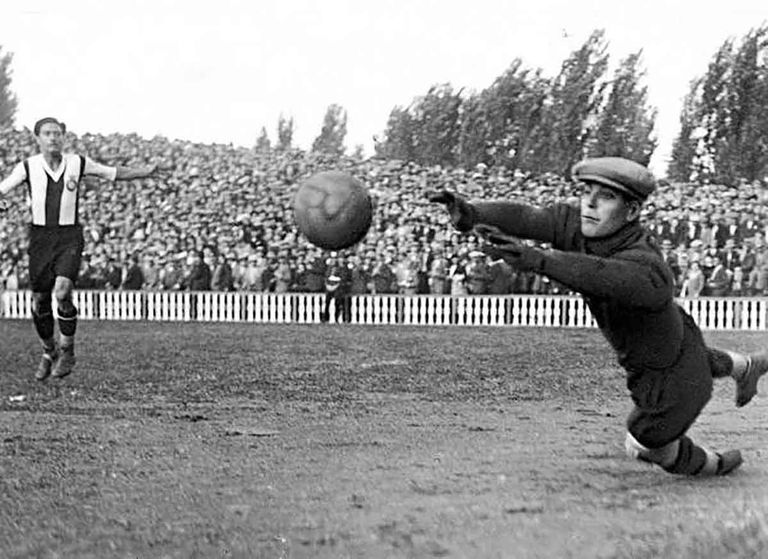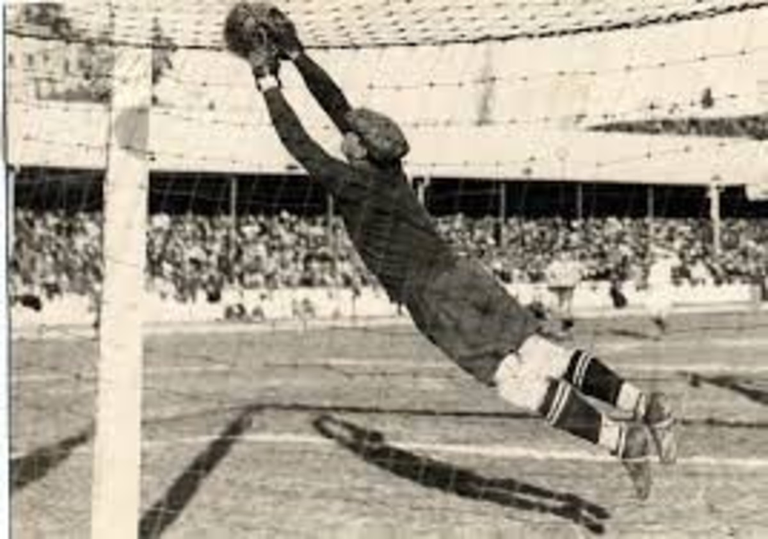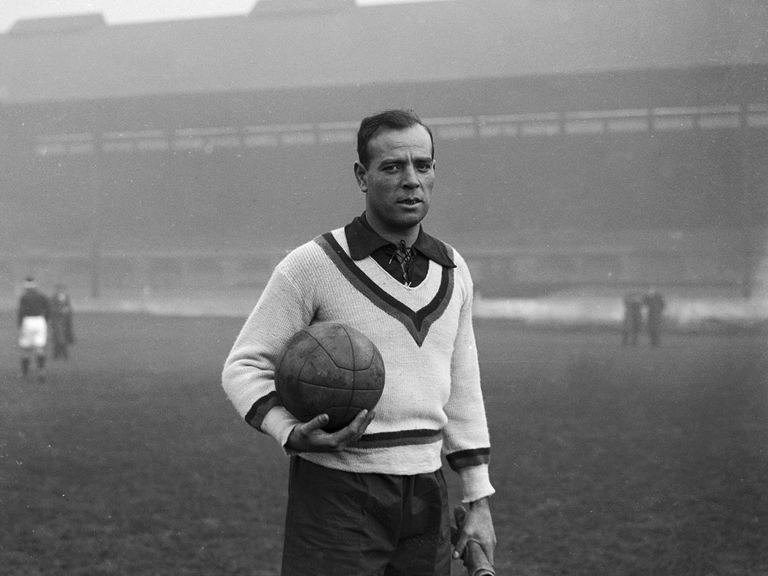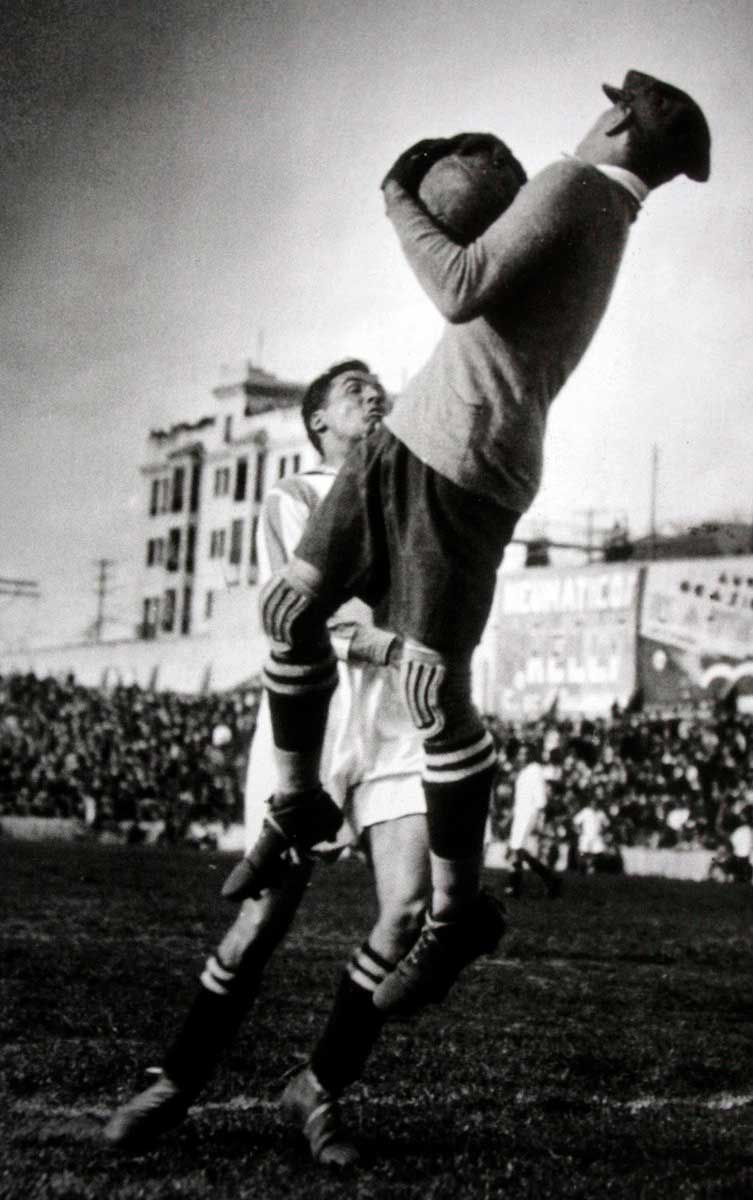
In the constellation of stars of Barcelona, little or nothing is said about Victor Valdes. There is praise for all the members of the -perhaps- best team of all time, but for the goalkeeper almost no one offers grandiloquent adjectives nor do the newspapers dedicate covers to him. And, by a wide margin, he is the least televised player of this team that builds its pedestal by passing so many records.
Ricardo Zamora was a figure of Barcelona and Real Madrid. Symbol of the 20s and 30s, he is considered one of the best in his position of all time. He is also pointed out as the first media man in history. He ended his career in exile, due to the Civil War.
But there is La Pantera de Hospitalet : almost always on target, appearing just the necessary, without moving shots, with simplicity, with his striking ability in accordance with the circumstances. In his own way, he became the perfect tribute to a legend: he has already won five Zamora Trophies - four of them consecutively in the most recent seasons - and this season he is heading for his sixth consecration (competing, above all, with the Argentine Wilfredo Caballero, from Malaga).
He has already caught up with another historical reference in the position: Antoni Ramallets, a celebrity in the Catalan world. "It's always nice to win a Zamora," he said last year when receiving the award, after having scored only 28 goals in 35 matches. When Valdes was born, in 1982, Ricardo Zamora Martínez - idol of the two giants of Spanish football - was no longer in this world. He had passed away a little less than three years before. But his legend lived on. Zamora was a crack in goal. Real Madrid, which places him among its "Legendary Players", describes him on its official website: "He was known as El Divino (The Divine One ). An adjective that describes the effect Zamora had on fans and opposing forwards. His time in Spanish football left a deep mark.
His always perfect position covering the goal, the confidence he showed in all his actions, his incredible reflexes, nerves of steel and personality. Without a doubt one of the best Spanish players in history. (...) He was the most important footballer of the 1930s in Spain, both on and off the field. He had all the qualities imaginable in a goalkeeper." It is a curious case seen through the eyes of this time of exaggerated rivalries: he arrived at Real Madrid after being - some years before - a reference in Barcelona, in the times of the memorable José Samitier. In the two great cities of Spain his name and surname are venerated in the same way. He was a celebrity of the 20s and 30s. There is hardly anyone left who has seen him play.
But his skills and his saves became mythology and went down in history. FIFA, which also consecrates him as an elite figure in history in its Hall of Fame, defines him: "He brought together the virtues of an exceptional goalkeeper: feline reflexes, nerves of steel, strong personality and great security between the sticks. And an impressive confidence in his qualities, so much so that he invented his own save, the 'zamorana', which consisted of clearing the ball with the forearm or elbow: a risky move that few dare to replicate." Zamora began his career at Espanyol in Barcelona when he was barely 15 years old and finished it at 37 playing for Nice, as an exile from the Civil War . His father did not want him to be a footballer. He wanted him to study medicine like him. But it was no use: the more they insisted, the more he insisted on flying far away until he became invincible.

Zamora once said: "I had promised my parents that I would leave football to finish my studies. But I continued to meet up with friends to play and the Barça board came to talk to me. "It took them little to convince me to take up the boots and gloves again." In 1919, he joined the Catalan giant at birth. And in times when the League did not exist, he won the most important trophy twice: the Spanish Cup. Plus: Barcelona won the four Catalan Championships that they contested with him in goal. But the Espanyol directors took revenge and brought him back to their club, in 1922, with a recipe that was not typical of those days: a lot of money. They paid him 25,000 pesetas for the transfer and another 5,000 as a monthly salary. Record figures at that time that today would be a handful of euros. In 1929, the Periquito team won its first important title: the Spanish Cup. The goalkeeper had a lot to do with it.
Then, with the League already founded and underway, he was hired by the most powerful: Real Madrid. He arrived and was injured. When he recovered for the 1931-32 season, he made the difference: the team from the capital celebrated the title and repeated the following year. And in the three following seasons, he fueled his glory with two Cups. There was a key match in his career: in 1936, in the last official match played before the Civil War, Real Madrid had to face Barcelona at Mestalla. His team was winning 2-1 and had ten players. Then, the superhero appeared. A chronicle of the time recounted it: "The goalkeeper senses the trajectory of the ball and manages to stop the ball without the spectators being able to explain how that could have happened. A tremendous ovation for Ricardo Zamora, who would later be carried on the shoulders of the enthusiastic fans." With his intervention, Real Madrid guaranteed victory and consecration.
That was his last performance as a goalkeeper on Spanish soil. The horrors of war forced him to emigrate to the south of France. With the Spanish national team he had won the silver medal at the Olympic Games in Antwerp in 1920. And he had a memorable role in the 1934 World Cup, when Spain came very close to pulling off a coup and eliminating the local Italy in the quarter-finals. They tied 1-1 in a match remembered as something close to a battle and which left the goalkeeper injured. It was not the era of penalties to decide matches. The match had to be replayed and Spain, now without Zamora, fell 1-0 to the Italians, who would later be crowned champions.
In his time as a coach (for example, he was a two-time champion with Atlético de Madrid, then Atlético Aviación), he continued to offer advice for the position he held. He said in an interview: "You must never lose sight of the ball until you have it completely under control. And that is very true and it happens to many goalkeepers, who do not look at the ball until the last moment, they think they already have it in their possession, they look the other way and lose control. You also have to learn the sense of positioning; but positioning in a goalkeeper is a somewhat innate question, it is not easy to learn it. Like reflexes, you are either born with them or you do not acquire them. You can improve them a little, there are some ways. But it is not that simple." Zamora always knew it: he was born to be a goalkeeper. Now retired, he became a teacher of his passion. Not only was he ahead of his time in goal; he was also an innovator off the field of play. Many recognize him as the first media footballer (others say it was Paulino Alcántara, the Filipino striker for Barcelona; and some certify that this sort of recognition corresponds to the Argentine Guillermo Stábile).
Zamora was the protagonist of several advertisements during the founding times of the advertising industry, in the 1930s. A detail tells of his relevance at that time: a collection of little pictures was all the rage, which, placed in order, served children to quickly go through and reproduce a save by the immense goalkeeper. Zamora was also shown in the cinema. He participated in two films: in 1942, in "Campeones", together with his Real Madrid teammates, Jacinto Quincoces and Guillermo Gorostiza; and in 1954, in "Once pares del Botas" with his friend Samitier. Five years later, the newspaper Marca began to award the prize that bears his name to the goalkeeper with the fewest defeats each season. Since then, Zamora has also become a divine trophy.

En la constelación de estrellas del Barcelona, poco o nada se dice de Víctor Valdés. Hay elogios para todos los miembros del -quizá- mejor equipo de todos los tiempos, pero para el portero casi nadie ofrece adjetivos grandilocuentes ni los periódicos le dedican portadas. Y, por un amplio margen, es el jugador menos televisado de este equipo que construye su pedestal a base de batir tantos récords.
Ricardo Zamora fue figura del Barcelona y del Real Madrid. Símbolo de los años 20 y 30, es considerado uno de los mejores en su posición de todos los tiempos. También se le señala como el primer hombre mediático de la historia. Terminó su carrera en el exilio, debido a la Guerra Civil.
Pero ahí está La Pantera de Hospitalet : casi siempre a puerta, apareciendo lo justo, sin tiros en movimiento, con sencillez, con su capacidad de golpeo acorde con las circunstancias. A su manera, se convirtió en el perfecto homenaje a una leyenda: ya ganó cinco Trofeos Zamora -cuatro de ellos consecutivos en las últimas temporadas- y esta temporada va por su sexta consagración (compitiendo, sobre todo, con el argentino Wilfredo Caballero, del Málaga).
Ya ha alcanzado a otro referente histórico en el puesto: Antoni Ramallets, toda una celebridad en el mundo catalán. «Siempre es bonito ganar un Zamora», dijo el año pasado al recibir el galardón, después de haber marcado sólo 28 goles en 35 partidos. Cuando Valdés nació, en 1982, Ricardo Zamora Martínez -ídolo de los dos gigantes del fútbol español- ya no estaba en este mundo. Había fallecido poco menos de tres años antes. Pero su leyenda seguía viva. Zamora era un crack en la portería. El Real Madrid, que lo sitúa entre sus «Jugadores Legendarios», lo describe en su web oficial: «Se le conocía como El Divino. Un adjetivo que describe el efecto que Zamora causaba en aficionados y delanteros rivales. Su paso por el fútbol español dejó una profunda huella.
Su posición siempre perfecta cubriendo la portería, la seguridad que mostraba en todas sus acciones, sus increíbles reflejos, nervios de acero y personalidad. Sin duda uno de los mejores jugadores españoles de la historia. (...) Fue el futbolista más importante de los años 30 en España, tanto dentro como fuera del campo. Tenía todas las cualidades imaginables en un portero». Es un caso curioso visto con los ojos de esta época de rivalidades exageradas: llegó al Real Madrid después de ser -unos años antes- una referencia en el Barcelona, en tiempos del memorable José Samitier. En las dos grandes ciudades de España su nombre y apellido se veneran de la misma manera. Fue una celebridad de los años 20 y 30. Ya casi no queda nadie que le haya visto jugar.
Pero sus habilidades y sus paradas se convirtieron en mitología y pasaron a la historia. La FIFA, que también lo consagra como figura de élite de la historia en su Salón de la Fama, lo define: «Reunía las virtudes de un portero excepcional: reflejos felinos, nervios de acero, fuerte personalidad y gran seguridad bajo los palos. Y una confianza impresionante en sus cualidades, hasta el punto de que inventó su propia parada, la 'zamorana', que consistía en despejar el balón con el antebrazo o el codo: una jugada arriesgada que pocos se atreven a replicar.» Zamora comenzó su carrera en el Espanyol de Barcelona cuando apenas tenía 15 años y la terminó a los 37 jugando en el Niza, como exiliado de la Guerra Civil . Su padre no quería que fuera futbolista. Quería que estudiara Medicina como él. Pero fue inútil: cuanto más insistían, más se empeñaba él en volar lejos hasta hacerse invencible.

Zamora dijo una vez: «Había prometido a mis padres que dejaría el fútbol para terminar mis estudios. Pero seguí quedando con amigos para jugar y la directiva del Barça vino a hablar conmigo. «Les costó poco convencerme para que volviera a coger las botas y los guantes». En 1919 ingresó en el gigante catalán. Y en tiempos en los que no existía la Liga, ganó dos veces el trofeo más importante: la Copa de España. Más: el Barcelona ganó los cuatro Campeonatos de Cataluña que disputó con él en la portería. Pero los directivos del Espanyol se tomaron la revancha y lo trajeron de vuelta a su club, en 1922, con una receta que no era propia de la época: mucho dinero. Le pagaron 25.000 pesetas por el traspaso y otras 5.000 como salario mensual. Cifras récord en aquella época que hoy serían un puñado de euros. En 1929, el equipo periquito ganó su primer título importante: la Copa de España. El portero tuvo mucho que ver en ello.
Luego, con la Liga ya fundada y en marcha, fue contratado por el más poderoso: Real Madrid. Llegó y se lesionó. Cuando se recuperó para la temporada 1931-32, marcó la diferencia: el equipo de la capital celebró el título y repitió al año siguiente. Y en las tres temporadas siguientes, alimentó su gloria con dos Copas. Hubo un partido clave en su carrera: en 1936, en el último partido oficial disputado antes de la Guerra Civil, el Real Madrid tuvo que enfrentarse al Barcelona en Mestalla. Su equipo ganaba 2-1 y contaba con diez jugadores. Entonces, apareció el superhéroe. Lo contaba una crónica de la época: «El portero intuye la trayectoria del balón y consigue pararlo sin que los espectadores puedan explicarse cómo pudo ocurrir. Una tremenda ovación para Ricardo Zamora, que más tarde sería llevado a hombros por los entusiastas aficionados». Con su intervención, el Real Madrid se garantizó la victoria y la consagración.
Aquella fue su última actuación como portero en suelo español. Los horrores de la guerra le obligaron a emigrar al sur de Francia. Con la selección española había ganado la medalla de plata en los Juegos Olímpicos de Amberes en 1920. Y tuvo un papel memorable en el Mundial de 1934, cuando España estuvo a punto de dar un golpe de efecto y eliminar a la local Italia en cuartos de final. Empataron 1-1 en un partido recordado como algo cercano a una batalla y que dejó al portero lesionado. No era la época de los penaltis para decidir los partidos. Hubo que repetir el partido y España, ya sin Zamora, cayó 1-0 ante los italianos, que luego se proclamarían campeones.
En su época de entrenador (por ejemplo, fue bicampeón con el Atlético de Madrid, luego Atlético Aviación), siguió dando consejos para el cargo que ocupaba. Lo dijo en una entrevista: «Nunca debes perder de vista el balón hasta que lo tengas totalmente controlado. Y eso es muy cierto y les pasa a muchos porteros, que no miran el balón hasta el último momento, creen que ya lo tienen en su poder, miran para otro lado y pierden el control.
También hay que aprender el sentido de la colocación; pero la colocación en un portero es una cuestión un tanto innata, no es fácil aprenderla. Como los reflejos, o se nace con ellos o no se adquieren. Puedes mejorarlos un poco, hay algunas maneras. Pero no es tan sencillo». Zamora siempre lo supo: nació para ser portero. Ya retirado, se convirtió en maestro de su pasión. No sólo fue un adelantado a su tiempo en la portería; también fue un innovador fuera del terreno de juego. Muchos le reconocen como el primer futbolista mediático (otros dicen que fue Paulino Alcántara, el delantero filipino del Barcelona; y hay quien certifica que este tipo de reconocimiento corresponde al argentino Guillermo Stábile). Zamora fue protagonista de varios anuncios en los tiempos fundacionales de la industria publicitaria, en la década de 1930.
Un detalle da cuenta de su relevancia en aquella época: estaba de moda una colección de dibujitos que, colocados en orden, servían a los niños para repasar y reproducir rápidamente una atajada del inmenso arquero. Zamora también se dejó ver en el cine. Participó en dos películas: en 1942, en «Campeones», junto a sus compañeros del Real Madrid, Jacinto Quincoces y Guillermo Gorostiza; y en 1954, en «Once pares del Botas», con su amigo Samitier. Cinco años más tarde, el diario Marca comenzó a conceder el premio que lleva su nombre al portero con menos derrotas cada temporada. Desde entonces, Zamora se ha convertido también en un trofeo divino.

I hope you liked this post. If you have any questions, queries or would like to add to this post, please feel free to write in the comments section.
Espero que esta publicación te haya gustado. Si tienes alguna duda, consulta o quieras complementar este post, no dudes en escribir en la zona de comentarios.



Sources consulted (my property) for the preparation of this article. Some paragraphs may be reproduced textually.
Source images / Fuente imágenes: Clarín Deportes.
Fuentes consultadas (de mi propiedad) para la elaboración del presente artículo. Algunos párrafos pueden estar reproducidos textualmente.
| Argentina Discovery. |  |
|---|---|
| Galería Fotográfica de Argentina. |  |
| Viaggio in Argentina. |  |
Upvoted. Thank You for sending some of your rewards to @null. Get more BLURT:
@ mariuszkarowski/how-to-get-automatic-upvote-from-my-accounts@ blurtbooster/blurt-booster-introduction-rules-and-guidelines-1699999662965@ nalexadre/blurt-nexus-creating-an-affiliate-account-1700008765859@ kryptodenno - win BLURT POWER delegationNote: This bot will not vote on AI-generated content
Thanks!